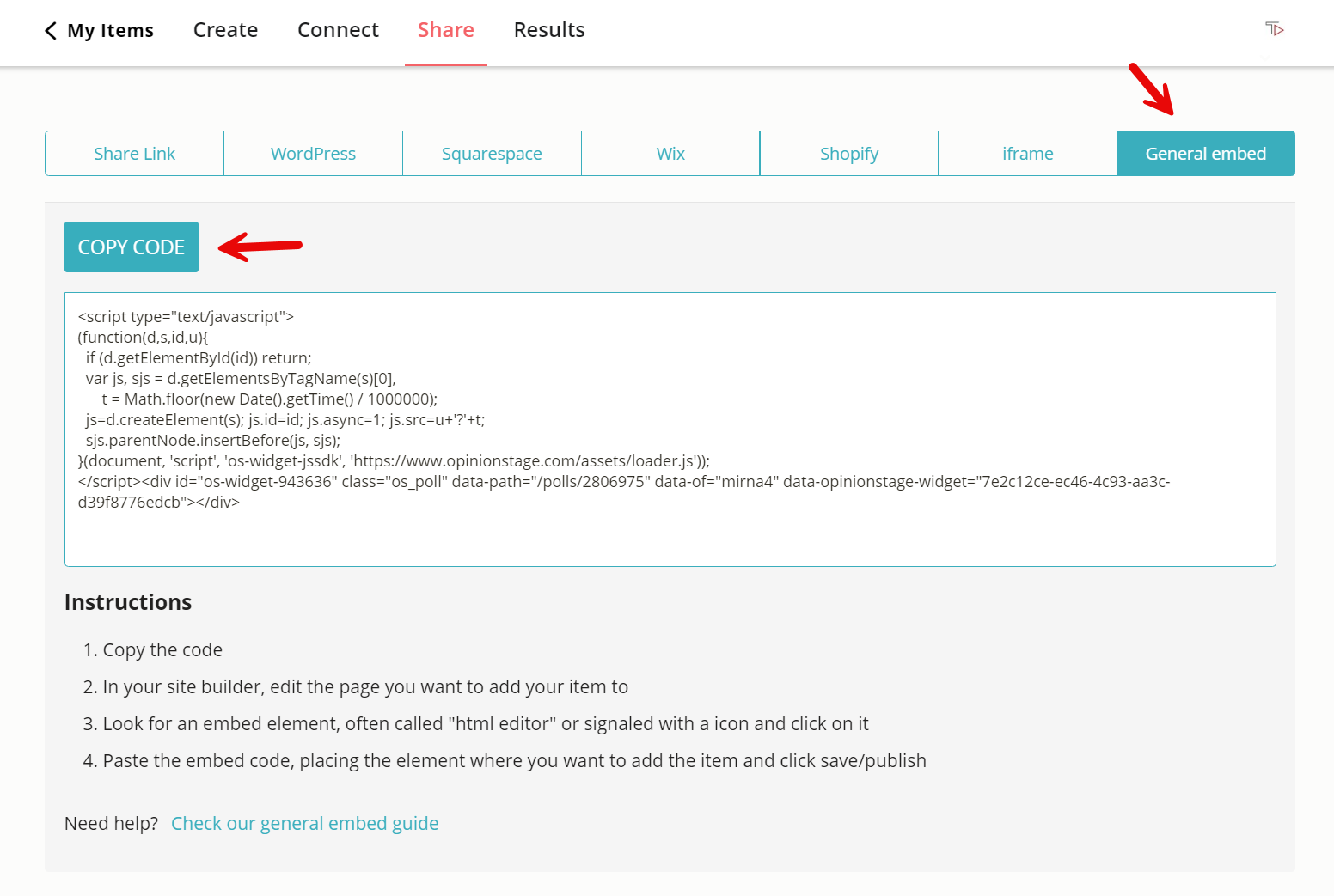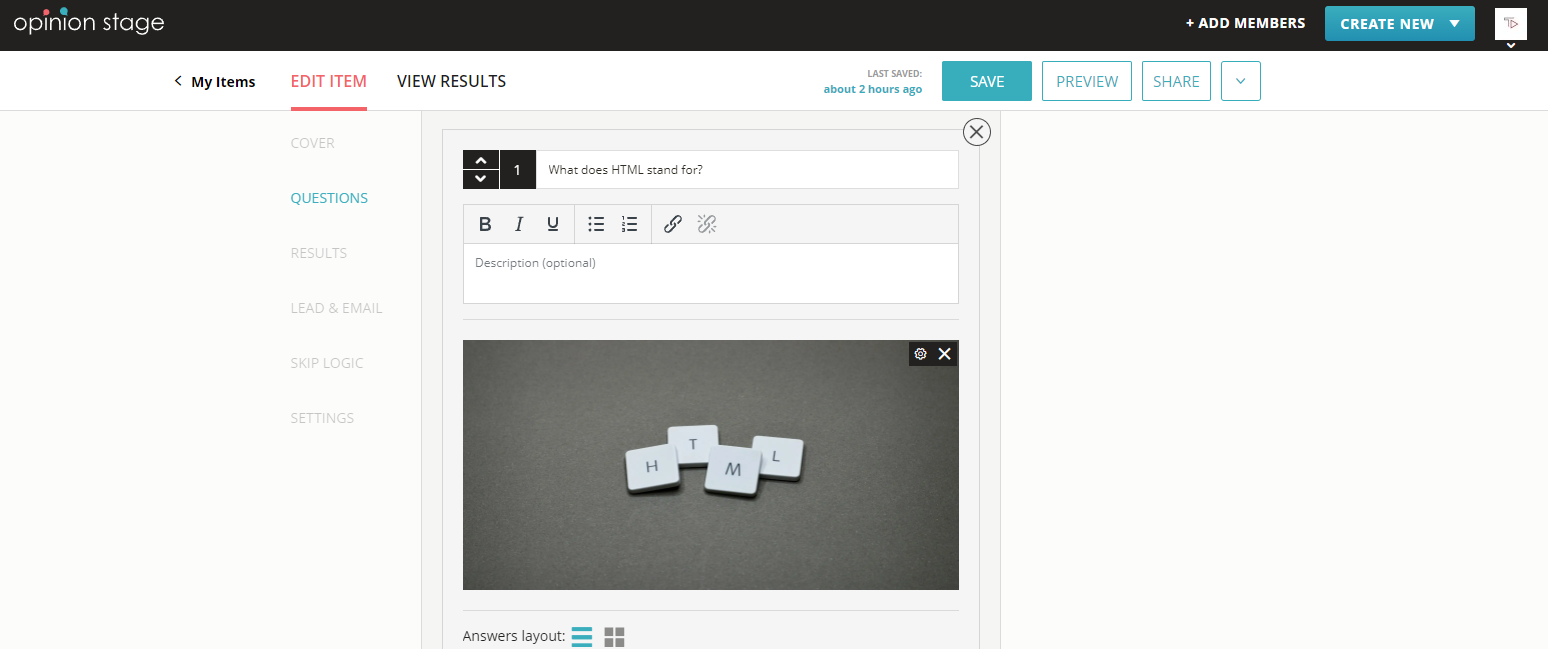How to Create an HTML Quiz
Learn how you can make your own customized HTML quiz by following these easy steps.
2. Copy the HTML code
Click on the ‘Share’ button at the top of your screen and then select the ‘General embed’ tab. Copy the code.

3. Add the HTML code to your Site
Now it’s time to add the code to your website. Decide where you want to place your quiz and paste it accordingly. You could add it to any page or post, put it in the sidebar, or even in a popup window.
And now you’re done!
Ready to get started?
Create an HTML QuizWhat Type of HTML Quiz Should I Make?
It all starts with your goal. Once you have a clear goal in front of you, choosing the type of quiz that will help you reach it is easy. There are many types of quizzes to choose from, each designed to offer a different experience and answer a specific need. Here are some examples:
- Interactive knowledge assessments help you measure your audience’s grasp of a certain topic.
- Product recommendation quizzes help you point your audience towards products or services that match their needs.
- Lead generation quizzes increase the number of leads you get and improve their quality.
- Diagnostic quizzes can be used to measure knowledge or to assist in medical diagnosis. For example, a Covid-19 diagnostic quiz could ask about symptoms and recommend the next steps based on the answers.
- Competitive quizzes help boost engagement by creating an exciting contest with a trivia quiz. A quiz competition usually works best with a time limit as well as a prize incentive.
The list goes on and on, but when you zoom out you’ll see that all quizzes can be separated into two major groups: trivia quizzes and personality quizzes (unless you’re actually looking to create an HTML survey or an HTML form). Let’s take a deeper look at these two quiz types.
Personality Quiz
There are countless differences between people, we are each unique in our own way. But we also tend to fit into groups, and we’re always eager to identify and find those groups because we’re social creatures and we want to belong.
Personality quizzes help us discover which groups we fit into. That’s why they’re so good for engagement. A good personality quiz can easily achieve up to 80% participation rates and 90% completion rates.
In personality quizzes, there are no successes and failures, or incorrect and correct answers. It’s all about learning more about ourselves, clarifying our needs, and expressing preferences.
The way it works is very simple. You, the quiz creator, decide on your topic and possible outcomes, each outcome represents a different group or type. Then you write down a series of multiple-choice questions that could help you understand who belongs to each group and associate each answer option with the outcome it supports.
What’s your skin type, your love language, or your personality type? Which superstar, animated character, or politician do you resemble? What kind of employee, learner, or parent are you? These are just a few examples of questions you can answer with a personality quiz.
Check out our personality quiz templates to choose the one that will best suit your next HTML quiz or learn more about our personality quiz maker.
Trivia Quiz
Unlike personality quizzes, trivia quizzes are all about incorrect and correct answers. They’re designed to test and measure knowledge, and they’re great for engagement because they tap into our oh-so-competitive nature.
To build a trivia quiz all you need to do is choose a topic and ask a series of multiple-choice questions about it. Make sure one of the answers in each question is in fact the correct answer and then move on to set the result cards. Here you will tell people how well they did, how many answers they got right, and what that says about them. For example, they may be a “math genius” if they got 8-10/10 or a “math novice” if they got 0-3/10.
Depending on your goal, you could use a trivia quiz to invite people to compete against each other, limit time, and encourage them to compete against the clock, or simply let them compete against themselves.
You could use the trivia format for many different purposes. Some examples: create a trivia competition for your email list members to get them more engaged with your emails, use language quizzes in a class enrollment process to check levels of proficiency, or add a quiz competition to your marketing strategy to spice things up and get more shares.
Keep in mind that while competitiveness may drive engagement, trivia is also a way to offer new knowledge. Whether you get an answer right or wrong, you’re more likely to internalize the information when you take an active part in learning it than you are if someone just explains it to you. Furthermore, you can add follow-up questions and answer explanations to enrich people’s knowledge while they take the quiz.
So if you’re looking for a fun way to engage with your audience while teaching them something new and learning more about them check out our trivia quiz templates or make your own HTML quiz from scratch with our trivia maker.
Best Practices for Creating an HTML Quiz
Get people excited about your content, Improve audience loyalty, and spark conversions. The next few tips will help you make your HTML quiz pop.
Get to Know Your Audience
Before choosing the type of quiz that will best suit your target audience, you need to get to know them a bit better. What are their interests, where are they located, what language do they speak, and what do you know about their digital and social media behavior?
After you’ve answered these questions, create your quiz based on your audience analysis. The better you know them the easier it will be to get them curious and clicking.
Make It Personal
Personalized content performs better because it makes people feel seen and heard. You can easily personalize your question path with skip logic, which sends people to different questions based on their answers to the previous question. It’s a simple, no-code feature that makes a big difference in user experience.
By the way, quizzes can also help you personalize the rest of your content. Add a lead form to your quiz, use quiz answers and results to segment your audience, and follow up with content that’s tailored to their interests and needs.
Keep It Short
Shorter quizzes perform better than longer ones. They get better engagement, more completions, and as a result, more shares on social media, so keep it short and sweet.
If you’re making a trivia quiz go for 7-15 questions and if you’re making a personality quiz try for 5-10 questions. That’s enough for people to enjoy your quiz without wasting too much of their time or tiring them out.
Looking to ask only one engaging question? Make an HTML poll, it literally takes seconds.
Add Visuals to Your HTML Quiz
Images and videos are crucial when it comes to capturing your audience’s attention and creating a memorable impact.
To illustrate this point, did you know that if you hear a piece of information, you’ll probably remember 10% of it three days later, but if you add a picture to the audio you’ll remember 65%?
The same goes for your quizzes. If you add images or videos to your questions and answer options, people will not only have more fun answering them they’ll also better remember the information you give them.
Visuals are also major engagement boosters, so don’t underestimate the importance of your cover image. The quality of the visual you add to your cover will be the key element determining the number of clicks on the start button of your quiz.
Choose the Right Spot for Your HTML Quiz
Consider where you’ll be placing your HTML quiz on your site. Will visitors be able to see and access it easily? Good placement options are in the mainstream above the fold or in a popup window.
But it all depends on your goal of course. Since our quizzes are fully responsive and mobile-friendly, you can place them anywhere and they’ll look great.
You Can Easily Do It Yourself, No Need For A Developer!
Create an HTML Quiz